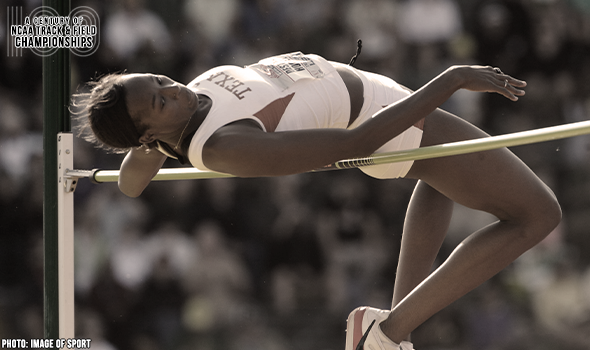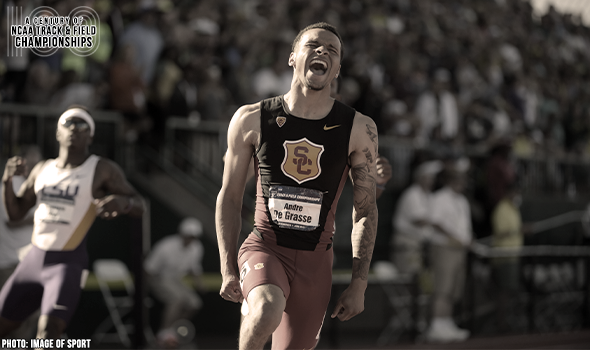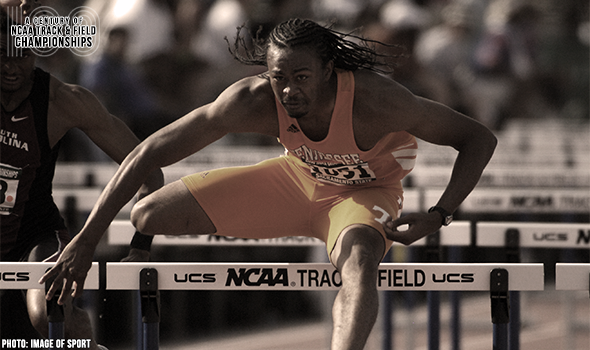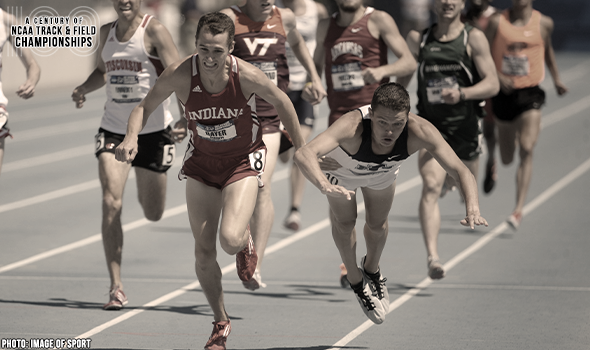
ON THIS DAY: Kerley Set 400-Meter CR In Austin
Going into the 2017 outdoor season, no collegian had gone sub-44.00 in the 400 within the confines of the collegiate season. Quincy Watts of Southern California held the collegiate record at that exact mark since his victory at the 1992 NCAA Division I Outdoor Track & Field Championships in Austin, Texas.
Indoors, Fred Kerley of Texas A&M made his presence felt that year with a few of the fastest marks in collegiate history. Kerley ripped two laps in 45.02 in his season opener at the Clemson Tiger Paw for what was the No. 3 spot on the all-time chart. Fast forward to the postseason and Kerley lowered his PR to 44.94 at the SEC Indoor Championships, in turn setting an all-time collegiate best on an oversized track. Then, Kerley went even faster in front of his home crowd at the NCAA Indoor Championships, winning the 400-meter title in 44.85 to become the fourth-fastest man in world history.
Get your popcorn ready, folks. It’s about to get good.
Even though Kerley didn’t make his outdoor debut until mid-April at the Michael Johnson Classic, he didn’t show any signs of rust. Kerley stopped the clock at 44.60 for what was the third-fastest mark in collegiate history that early in the season (The only two men two who ran faster were Vernon Norwood of LSU in 2015 at 44.44 and Watts in 1992 at 44.46).
Magic followed three weeks later at the SEC Outdoor Championships, where Kerley scorched a 44.09 in the prelims for the second-fastest, in-season collegiate performance behind Watts’ near 25-year-old record. Read that again, though: Kerley did that in the prelims.
After winning the SEC title at 44.30 – a time slowed by inclement weather, in which Kerley said he “didn’t adjust anything … but I was racing, instead of just running my race today” – he turned his attention to the all-important NCAA postseason.
Getting to the quarterfinals of the NCAA DI West Preliminary Round in Austin, Texas, proved easy for Kerley, as he clocked a comparatively-pedestrian 45.95 to win his first-round section.
Given the high-stakes nature of the ensuing afternoon, Kerley had a championship mindset.
“I was running smart yesterday to set up the race for today,” Kerley said after the meet. “Coach (Alleyne) Francique and I were talking about the collegiate record being set in Austin and it would be wonderful to break it here in front of him. I just want to keep on improving.”
Everybody in attendance at Mike A. Myers Stadium – including Watts, then and now an assistant coach at Southern California – knew what was coming next. On May 26, 2017, exactly four years ago today, Kerley covered 400 meters in 43.70 to demolish Watts’ collegiate record and become the seventh-fastest man in world history.
Several weeks later, Kerley completed the NCAA sweep with a 44.10 effort at Historic Hayward Field and anchored the Aggies to 4×400 relay glory with a 43.99 split. Kerley’s margin of victory in the 400 was 0.59 seconds, the largest in meet history since 1992 (If you don’t know who won that race, then you haven’t been paying attention: Quincy Watts by 0.84 seconds).
The NCAA and collegiate track & field will mark a momentous milestone in the spring of 2021 -- the 100th anniversary of the NCAA Championships and with that, the NCAA Track & Field Championships. In June 1921, the University of Chicago hosted the first track & field championships in NCAA history.
This point can’t be emphasized enough: Not only was the event the first for NCAA track & field, but the first championships for any sport under the sponsorship of the NCAA.
To celebrate, over each of the next 365 days, the U.S. Track & Field and Cross Country Coaches Association (USTFCCCA) will celebrate moments, student-athletes, and coaches that have made a century’s worth of championships special. From humble beginnings to important historical milestones to the modern-day, collegiate track & field has evolved with the American society.
The 2021 edition of the NCAA Division I Outdoor Track & Field Championships begin with preliminary round action on May 27-29 in Jacksonville, Fla., and College Station, Texas. The championships final site and culmination of the celebration is slated for June 9-12, 2021 at the newly rebuilt Hayward Field in Eugene, Ore.

Texas’ Hooker High Jumped To NCAA Glory
Destinee Hooker won three career high jump titles at the NCAA DI Outdoor T&F Championships, including a massive victory in 2009 by more than two inches.

De Grasse Sprinted To Otherworldly Double
Andre De Grasse completed the 100-200 double at the 2015 NCAA DI Outdoor T&F Championships with scorching times: 9.75 (+2.7) in the 100; 19.58 (+2.4) in the 200.

Merritt Broke Long-Standing 110H MR In 2006
Aries Merritt broke a 28-year-old meet record in the 110H when he won the crown at the 2006 NCAA DI Outdoor T&F Championships in 13.21.

UGA’s Torrence Made NCAA History With Double
Gwen Torrence completed the 100-200 double at the 1987 NCAA DI Outdoor T&F Championships. Torrence was also the first woman to finish top-8 four times in the 100.

Bayer Gave It His All For NCAA 1500 Title
Andrew Bayer won the 1500 at the 2012 NCAA DI Outdoor Track & Field Championships in one of the closest finishes in meet history – 0.01 seconds.

Tipton Led 1-2-3 Oregon Finish In 1964 JT
Les Tipton led the first podium sweep of any event in the history of the NCAA Outdoor T&F Championships. Tipton and his Oregon teammates went 1-2-3 in the 1964 javelin.

K-State’s Jones Captured Heptathlon Crown In 2015
Akela Jones won the heptathlon at the 2015 NCAA DI Outdoor T&F Championships with 6371 points. That is the fourth-best score in both collegiate history & meet history.

Same Athletes, Same Result For LSU At NCAAs
The LSU foursome of Bennie Brazell, Pete Coley, Robert Parham, Kelly Willie swept the 4×100 & 4×400 crowns at the 2003 NCAA DI Outdoor T&F Championships.

Martin Won Distance Titles For Two Programs
Francis (Frank) Martin made history twice in the NCAA Outdoor Track & Field Championships.

FSU’s Williams Soared To Jumps Double In 2009
Kim Williams swept the horizontal jumps at the 2009 NCAA DI Outdoor T&F Championships. Williams was particularly dominant in the TJ, winning at 14.38m (47-2¼) & by nearly 2 feet.

